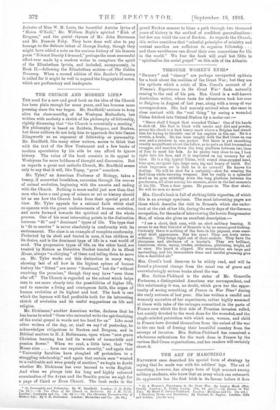THE ART OF MARCHING.t
NAPOLEOAT once described his special form of strategy by saying that be made war with his soldiers' legs. The art of marching, however, has always been of high account among military students, who know that an army which can outmarch its opponents has the first trick in its favour before it fires (1) A Woman's Ereperiences tin the Great War. ,By Louise Mack. (Mrs. Creed). London : T. Fisher Unwin. [10s. 6d. net.]—(8) Prance in War Tillie. By Maud P.. Sul ton.PIckhard. London Methuen and Co. [5s. net.] hrarch ing To and Evolutions. By Herbert E. Naylor. London: Gala end Poldeu. [1s.'6d. net.L
a shot or strikes a blow. We are apt, perhaps, to underrate the difficulties of marching, which is by no means like walking or reading or writing, a thing which comes by nature. Mr. Herbert E. Naylor, who has had in the recent course of his pro. fessional work to examine a number of students for gymnastic teachers' diplomas, tells us that they display a regrettable diversity of views with regard to marching. He has accord- ingly written a very complete, though commendably brief, treatise on the subject, which should be of service to the numerous persons who are now engaged in training our new levies. It must of course be borne in mind that the course of instruction which Mr. Naylor gives is much more elaborate than is usually employed in the Army. The marching which he teaches is to ordinary marching what a " musical ride" is to normal cavalry evolutions. The numerous diagrams with which his pages are elucidated—reminding the hasty reader of fireworks or figures in a kaleidoscope—illustrate evolu- tions vastly more complicated than are ever required in close-order drill. It is rather a pity that Mr. Naylor's nomen- clature differs from that in military use : thus he calls the familiar "left incline" a "one-eighth left turn," which may be geometrically more exact, but will be rather confusing to the recruit, and he speaks of " wheeling " a line where the drill-book describes the movement as "forming." We think it would have been better if he had adopted the accepted military terms as far as they go, and had only introduced new ones for the more elaborate motions of ornamental and figure marching. We are entirely at one with him in his insistence on the importance of spending as much time as possible on teaching the basic principles of marching, which is by no means a mere collective form of walking
" Walking, as a general rule, is simply a means to an end, or, in other words, the covering of a distance on foot, while the object of marching is to cultivate uniformity of step, style, rhythmic movement, good bodily carriage, and discipline. . . . With the measured step, which ultimately produces an easy gait and co-ordinate movement, the hip, knee, and ankle joints develop strength and elasticity. It is the lack of these attributes which is responsible for the `shuffling' movements that unfortunately many young people, as well as old, have. . . . It needs little argu- ment to carry a decision in favour of training in marching where the movement of a large number of men over long distances is involved, as it is evident that a cultivated step and rhythmic movement will be more effective in accomplishing the task with a minimum of fatigue, than an uncontrolled and irregular action."



































 Previous page
Previous page